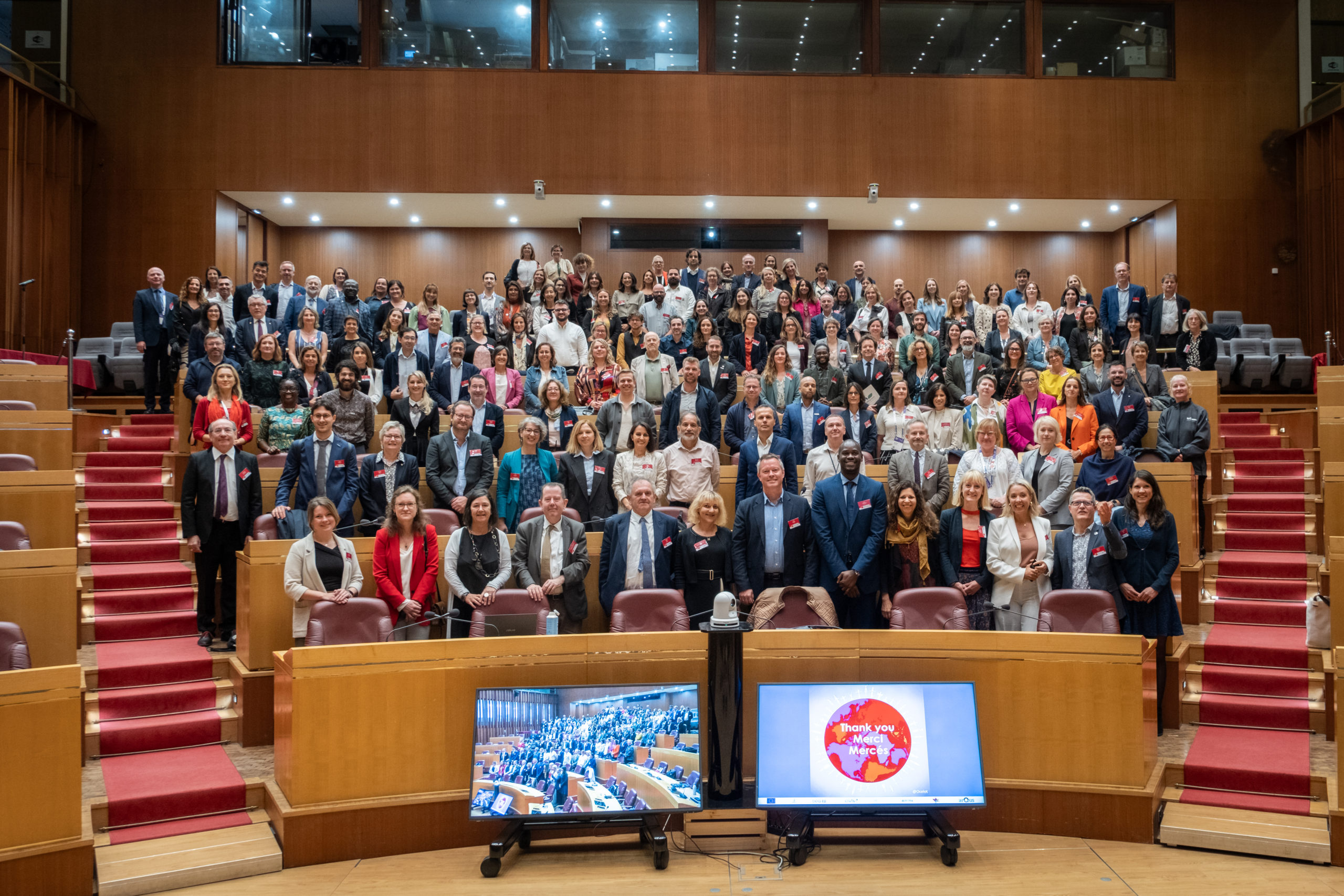From fostering innovation to offering joint degrees, these alliances address current challenges while positioning Europe as a leader in higher education. Their strategies align with EU priorities, as outlined in the European Council conclusions (2021) and the European Strategy for Universities (2022), in boosting competitiveness, fostering global cooperation and promoting a shared European identity. A key focus is cooperation with Ukrainian institutions, supporting Ukraine’s integration into the European education space, alongside partnerships with African institutions, addressing regional challenges and supporting sustainable development.
These topics were central to the discussions at the “Internationalisation of European Universities Alliances: The New Frontiers” event held on September 17 as a satellite activity of the EAIE conference in Toulouse and hosted by the Université de Toulouse and Région Occitanie. Opened by Ludovic Thilly (EC2U) and Olga Wessels (ECIU), the event provided a platform for high-level representatives from various alliances and partner countries outside the EU to engage with the European Commission and other key stakeholders on these topics.
Key highlights from the main sessions
During the first session, moderated by Dorothy Kelly (Arqus), the discussion explored why alliances pursue internationalisation beyond their members and how they contribute to the broader European education area. Vanessa Debiais-Sainton, head of unit at DG EAC, referenced the Draghi report, emphasising the need for alliances to address skills gaps in AI, aerospace, and green technologies. She highlighted the launch of the new Union of Skills, covering higher education, vocational training, and lifelong learning, and the blueprint for a European Degree. By pooling resources, alliances can offer more efficient, relevant degrees that meet Europe’s future needs. Debiais-Sainton used the metaphor of Olympic medals, noting that while individual EU countries may fall behind global competitors, collectively, European universities can surpass them by sharing resources, equipment, and data. She also stressed the importance of private-sector partnerships and integrating institutions from the Western Balkans and Ukraine. In addition, it was particularly insightful to hear how alliances are positioned within the new policy agenda of the European Commission. Indeed, this session also aligned with the announcement that the new Vice-President for People, Skills, and Preparedness would oversee the EUAs, thus signifying a strategic commitment to enhancing collaboration, fostering skills development, and addressing the evolving needs of higher education in Europe. As Vanessa Debiais-Sainton expressed, “We see what you are capable of, and we count on you for the future.”
Carle Bonafous-Murat, permanent representative of France Universités in Brussels, addressed the strategic role of alliances in fostering international collaborations. He questioned whether internationalisation strategies should be thematic or more flexible, citing visits from Colombian and Argentine delegations exploring the topic of biodiversity in connections with European universities. While focusing on specific topics can drive solutions, it may limit alliances’ adaptability to broader trends. He also raised concerns about branding, asking if alliances should adopt a collective identity and whether institutions are willing to compromise their individual brands for a unified approach. Marie Azuelos (CIVICA) discussed how CIVICA integrates internationalisation into its central objectives, emphasising its efforts to strengthen ties with Ukrainian universities through the CIVICA for Ukraine initiative. This initiative shows how alliances can act as vehicles for informal diplomacy and co-creation, fostering solidarity in politically charged contexts. However, managing expansion while deepening partnerships poses challenges, particularly with a two-tier system of full members and international partners, complicating efforts to maintain a cohesive internationalisation strategy.
Mattia Bellotti (EUTOPIA) underscored the role of shared values like academic freedom and democracy in promoting international alliances. The alliance’s Young Leaders Academy, involving partners from South Korea, Australia, and South Africa, illustrates how shared values can underpin initiatives that develop future leaders while ensuring that students from diverse backgrounds benefit equally from these programs. Yet, as alliances strive to internationalise, they must ensure that such initiatives do not unintentionally privilege institutions with more significant resources or more established global networks. John Gardiner (Ulysseus) reinforced the importance of flexibility in partnerships, particularly with non-Erasmus countries like Vietnam and Canada. The Compass Project, a three-year initiative, shows how internationalisation brings fresh perspectives to European universities but also highlights the legal and regulatory challenges requiring adaptable governance to manage various frameworks and environments. Finally, Romiță Iucu (CIVIS) underscored the potential of alliances to break down institutional barriers through innovative learning models. His discussion of the project Digitally Enhanced Mobility showcases how alliances are at the forefront of redefining education in a post-pandemic world and how alliances represent a potential “new frontier” of diplomacy. To sum up, the discussion highlighted both the potential and challenges of expanding EUAs’ global reach. Initiatives like the European Degree show promise but risk dominance by wealthier institutions. Branding may strain identities, and the debate over thematic vs. broader internationalisation raises concerns about flexibility and governance.
Moderated by Karolina Ignatiuk (4EU+), the second session explored the evolving synergies between Ukrainian institutions and European university alliances, moving from crisis management to long-term cooperation. Kseniia Smyrnova (EUniWell) emphasised that Ukrainian universities are now strategic partners in joint research on topics like digitalisation and migration. “We are in an active phase of Europeanisation,” she stated, underscoring Ukraine’s role as a contributor, not just a recipient of aid. Iryna Osovska (UNITA) highlighted how the war has disrupted mobility programs, especially in rural areas. Osovska stressed the need for long-term solutions, including harmonising academic calendars, synchronising curricula, and expanding digital learning. Iryna Ivanets (EUPeace) illustrated these challenges with a video featuring Ukrainian students, providing insight into their experiences, and Jean-Marc Planeix (EPICUR) discussed efforts to formalise collaborations through joint statements and a Memoranda of Understanding in 2023, aimed at integrating Ukrainian institutions into Erasmus+ and Horizon Europe. However, bureaucratic hurdles and regulatory challenges persist. The Polish NAWA Agency has provided critical funding, but long-term sustainability remains a concern. Finally, Christine Fernandez (EC2U) and Taseusz Uhl (UNIVERSEH) showcased initiatives like summer schools and staff training involving various stakeholders from cities to SMEs. These efforts reflect a vision for sustainable integration, but challenges like infrastructure gaps and educational discrepancies remain. The discussion on Ukrainian universities transitioning from aid recipients to active contributors demonstrated the broader challenges of integrating institutions into European higher education. However, their success depends on overcoming bureaucratic barriers, infrastructure gaps, and securing long-term funding.
Similar obstacles were discussed in the third and final session, which focused on the collaboration between European and African universities. Moderated by Aliyah Morgenstern (YUFE), the discussion emphasised the diverse nature of these alliances. “We must foster hope and dreams,” she noted, underscoring the potential for synergies that benefit both African and European institutions. Maame Afua Nkurmah (Takoradi Technical University) mentioned the challenges young African universities face in gaining global visibility, questioning whether they should focus on specific topics or take a broader approach. Expanding on the issue of inequality, Mahomed Moolla (University of the Witwatersrand) emphasised the need for “equal partnerships in an unequal world”, with co-creation essential to addressing historical imbalances. Anisa Khan (UnaEuropa) reinforced the importance of co-creation, describing it as “the first principle” for building trust and compelling collaborations, pointing to initiatives like the UNAVEX virtual exchange, encouraging academic cooperation across continents. Continuing the theme of partnership challenges, Alexandra Teodósio (SEA-EU) spoke about collaborative maritime research with African institutions, made possible by projects like the Global Gateway Declaration. While these initiatives hold great promise, she emphasised that practical issues such as linguistic barriers and misaligned academic calendars often limit their scope, further complicating cross-continental cooperation. Shifting to more concrete examples, Marjanneke Vijge (Charm-EU) pointed out the success of the Capstone project in Senegal and South Africa, which led to joint research and exchanges. Laurent Thevenet (Aurora) discussed the alliance’s projects to further connect universities across European and Africa. In sum, the session underscored that while collaboration between European and African universities shows promise, challenges like global recognition and resource disparities persist.
The Alliances and the way forward
Internationalisation remains central to Europe’s strategy, driving competitiveness and strengthening its leadership in research and innovation. European University Alliances have immense potential to transform global higher education, yet they still face challenges like unequal resources, structural challenges, and managing diverse partnerships. Ukraine’s involvement is promising but slowed by infrastructure and funding shortfalls, while alliances with African universities require overcoming disparities. The event underscored the importance of co-creation, trust, and collective branding in forging a unified European higher education identity. Diversified funding is also crucial. While DG EAC provides vital support, additional contributions from other DGs, such as DG RTD, DG Employment and DG INTPA, are critical for long-term sustainability. National governments must also play their part by investing in these efforts, recognising that the EU’s role is to supplement, not replace, their contributions to the success of these alliances.
Ultimately, as these alliances push the ‘new frontiers’ of internationalisation, their success in shaping a more equitable global education system will depend on sustained commitment, strategic planning, capacity building, and addressing existing inequalities, ensuring a lasting impact in Europe and beyond.
Article by Dr Marina Cino Pagliarello – Marie Skłodowska-Curie Fellow, European University Institute




